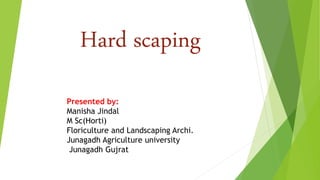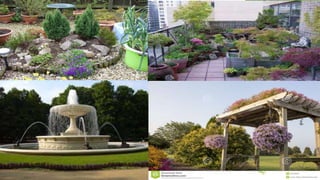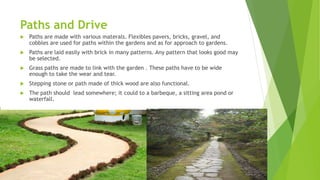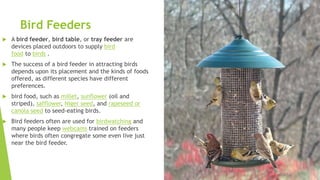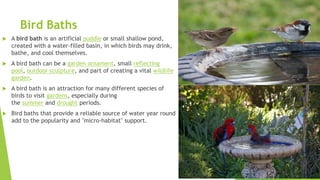Hardscaping
- 1. Hard scaping Presented by: Manisha Jindal M Sc(Horti) Floriculture and Landscaping Archi. Junagadh Agriculture university Junagadh Gujrat
- 2. Introduction Hardscaping means – man made features used in landscape It is most important and expensive part in the making of gardens. Hard landscap means the creation of beautiful walkways, paths, walls, terraces, and other elements of various structures . Hard landscaping constitutes an important area in the formation of a garden. Though these elements are attractive, the hard landscaping has to be sturdy and functional. It has to visually merge the building with the rest of the landscape. Hardscaping is all about bricks and mortar. It takes care of spaces, proportion, patios, driveway arbors and gates. it is employed in early stages of landscape to render the area a desired shape and add-on features. Hardscaping protects the soil by construction of vertical wall, pools, stone benches or paved walkways the loosening and erosion of soil is considerably webed.
- 3. The shape and style of hard landscaping has to merge into soft landscaping . By proper planning and integrating the two great landscapes can be created. The designer should be alert while preparing the hard landscape , the structures and their sizes are very important and the required area should be provide for sitting ,walking,eating and entertainment. Pathways should be such that the guests may go through the most important parts or spots of the garden from time to time ,all the focal points of hard landscaping should be observed. Hard landscaping includes building of pond, water fountains, water falls, indoor fountains, figurines and water bodies.
- 4. Focal points of Hard Landscaping Pergolas terraces Fountains waterfalls Rockeries These focal points take on the responsibility to keep the landscape live with the well crafted design and form till the fresh planting grow, establish them, and impress upon us their own individuality and contribution to making the garden beautiful.
- 6. Gravel and Cobbles Gravels and cobbles are used as loose and in a fixed manner- gravels and cobbles are same but cobbles are larger than gravel. Both have severel uses. Both can be used anywhere, it could be informal paving and are a visual link between the landscape and garden plants. They can be used to enhance planting, rockeries and base of trees, for decorative purpose to prevent soil erosion, on soil contours. Laying loose gravel and cobbles would allow the tree roots to breathe, absorb water and to some extent hold the soil. The gravel requires to be retained by giving it some spport. A support can be given by some sort of paving. In case it is near a soft surface like grass or planting, a strong edge is required; this could be done by giving it a proper attractive support by laying bricks on the edge. The bricks should be strong and of good quality. The bricks are required to be set in mortar concrete; the gravel should be within ½ inch of the top surface. If the gravel path touches the lawn, the grass should be ½ inch above the brick; this would facilitate the running of the mover along the top.
- 7. Cobbles are round or oval stones or larger gravels of up to 4 inch. Normally 2-4 inch size cobbles are used. Cobbles can be laid in various patterns and designs along with stones of different sizes. One way is to use them like gravel or pebbles. This requires fixing the gravel in regular pattern instead of setting them randomaly like gravels. Since cobbles are bigger in size, they should be rammed or tamped properly so that the higher edges are leveled well.
- 8. Paths and Drive Paths are made with various materals. Flexibles pavers, bricks, gravel, and cobbles are used for paths within the gardens and as for approach to gardens. Paths are laid easily with brick in many patterns. Any pattern that looks good may be selected. Grass paths are made to link with the garden . These paths have to be wide enough to take the wear and tear. Stepping stone or path made of thick wood are also functional. The path should lead somewhere; it could to a barbeque, a sitting area pond or waterfall.
- 9. Different types of Paving Brick Paths Gravel Paths Crazy Pavings Ceramic Piles Screening and Fences Pergola Arches Trellises Bird House Bird Feeders Bird Baths Garden and landscape bridges barbecues
- 10. Brick Paths Bricks are best for laying paths. Bricks always blend well in most gardens. They are morden, rustic, or traditional. Bricks always blend well in most gardens –they are morden, rustic, or traditional.
- 11. Gravel Paths It is relatively less expensive and easy to layout, but if not laid properly it also hurts. Most donot realize that this is very good for aqua pressure . Walking on gravels bare footed relaxes body and helps in many ways.
- 12. Crazy pavings Crazy paving is a means of hard- surfacing used outdoors, most frequently in gardens. Paving stones of irregular size and shape are laid in a haphazard manner sometimes with mortar filling the gaps between. The method originated in Ancient Rome.
- 13. Ceramic piles Ceramic tiles are made of an earth mixture which is high in clay, and fired to become ceramic. The process of building and firing such houses was developed by Iranian architect, Nader Khalili, in the late 1970s. he named it Geltaftan; "Gel", means "clay", and "taftan", means "firing, baking, and weaving clay" in Persian. it is permanent, water-resistant, and the four elements: earth and water to build the forms, and fire and air to finish them
- 15. Screening and Fences It is an important part of garden Hedges or planting screens require time to serve their purpose, febricated screens are often prefered as they can be set up faster and do not require much maintenance though they are more expensive than natural hedge Now a days simple Fencing is availble. Normally a brick wall proves to be the best for security and privacy Fencing and screening can be used as a peripheral fence to separate the garden from the house ; it could be expensive and aesthetic.
- 16. different type of Screening and Fences
- 17. Pergola A pergola is a garden feature forming a shaded walkway, passageway, or sitting area of vertical posts or pillars that usually support cross-beams and a sturdy open lattice, often upon which woody vines are trained. The origin of the word is the Late Latin pergula, referring to a projecting eave.It may also be an extension of a building or serve as protection for an open terrace or a link between pavilions. They are different from green tunnels. A pergola is a much larger and more open structure and does not normally include integral seating.
- 18. An arch is a curved structure that spans a space and may or may not support weight above it. Arch may be synonymous with vault, but a vault may be distinguished as a continuous arch forming a roof. Arches
- 19. Trellises Trellis may refer to: an architectural structure often used to support plants It is utilized in landscape as free standing to work as screens or wind breaks . Mainly made from wood they can be designed in a large range or shapes for various usuage, the lighter ones being made from steel for supporting plants against already made wall
- 20. Bird houses Birds are good friends of gardens. Apart from being decorative elements of gardens the bring joy to our lives.it is decorative outdoors elements of a garden Birdhouse can be made in many styles and designs . They are made in several shapes, generally from wood that is colored attractively
- 21. Bird Feeders A bird feeder, bird table, or tray feeder are devices placed outdoors to supply bird food to birds . The success of a bird feeder in attracting birds depends upon its placement and the kinds of foods offered, as different species have different preferences. bird food, such as millet, sunflower (oil and striped), safflower, Niger seed, and rapeseed or canola seed to seed-eating birds. Bird feeders often are used for birdwatching and many people keep webcams trained on feeders where birds often congregate some even live just near the bird feeder.
- 22. Bird Baths A bird bath is an artificial puddle or small shallow pond, created with a water-filled basin, in which birds may drink, bathe, and cool themselves. A bird bath can be a garden ornament, small reflecting pool, outdoor sculpture, and part of creating a vital wildlife garden. A bird bath is an attraction for many different species of birds to visit gardens, especially during the summer and drought periods. Bird baths that provide a reliable source of water year round add to the popularity and "micro-habitat" support.
- 23. Garden and Landscape Bridges The Bridge is a proposed pedestrian bridge over the water body Bridges form very important elements as accents. The bridge could be made of water resistant wood, Cedar wood, Teak wood, fabricated with steel frame and wooden planks. The bridge are to connect one area of the garden to another, or add beauty and peace to an outdoor area.
- 24. Barbecues Barbecue is refer as a fireplace or pit for grilling food, typically used outdoors and traditionally employing used outdoors and traditionally employing hot chorcoal as the heating medium. The utilty of it is limited during winter months . Simple concrete blocks can be used to build it, use of firebricks which have asthetic value and also suit the purpose can be used.
- 25. Thank you
